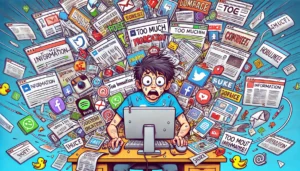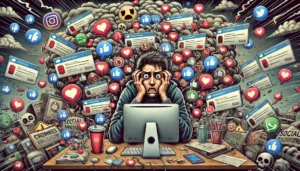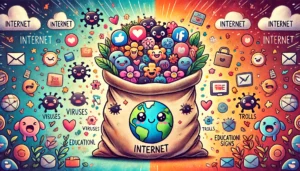Reading Practice for Intermediate: The Internet: Exploring Its Marvels and Missteps
A. Building Knowledge of the Field
Have students watch the video below to build their knowledge on the internet.
Have students answer the questions below orally!
- What is the Internet, and how does it connect people around the world?
- List at least two popular uses of the Internet mentioned in the video.
- How can the Internet be used to search for information, and what types of resources are commonly found?
- What role do social media platforms play in helping people stay connected according to the video?
- Why is it important to use the Internet safely, and what precautions should be taken?
These questions are designed to encourage students to think critically about the content of the video and articulate their understanding orally.
B. Related Words
Have students learn the following vocabulary to understand the upcoming text better. (Play the audio for each vocabulary word, have students repeat it, and then discuss the meaning together)
| 1 | Indispensable | Absolutely necessary; essential. | Error occurred when trying to fetch the file using wp_safe_remote_get(). A valid URL was not provided. |
| 2 | Repository | A place, building, or container where something is stored or deposited. | Error occurred when trying to fetch the file using wp_safe_remote_get(). A valid URL was not provided. |
| 3 | Democratization | The action of making something accessible to everyone. | Error occurred when trying to fetch the file using wp_safe_remote_get(). A valid URL was not provided. |
| 4 | Connectivity | The state or extent of being connected or interconnected. | Error occurred when trying to fetch the file using wp_safe_remote_get(). A valid URL was not provided. |
| 5 | Privacy | The state of being free from public attention or unsanctioned intrusion. | Error occurred when trying to fetch the file using wp_safe_remote_get(). A valid URL was not provided. |
| 6 | Data Breaches | Incidents where sensitive, protected, or confidential data is accessed or disclosed without authorization. | Error occurred when trying to fetch the file using wp_safe_remote_get(). A valid URL was not provided. |
| 7 | Identity Theft | The fraudulent acquisition and use of a person’s private identifying information, usually for financial gain. | Error occurred when trying to fetch the file using wp_safe_remote_get(). A valid URL was not provided. |
| 8 | Cyberbullying | The use of electronic communication to bully a person, typically by sending messages of an intimidating or threatening nature. | Error occurred when trying to fetch the file using wp_safe_remote_get(). A valid URL was not provided. |
| 9 | Mental Health | A person’s condition with regard to their psychological and emotional well-being. | Error occurred when trying to fetch the file using wp_safe_remote_get(). A valid URL was not provided. |
| 10 | Inadequacy | The state or quality of being insufficient or not enough. | Error occurred when trying to fetch the file using wp_safe_remote_get(). A valid URL was not provided. |
| 11 | Addictive | Causing or likely to cause someone to become dependent on a particular substance or activity. | |
| 12 | Screen Time | The amount of time a person spends looking at a screen, such as a computer, television, or smartphone. | |
| 13 | Misinformation | False or inaccurate information, especially that which is deliberately intended to deceive. | Error occurred when trying to fetch the file using wp_safe_remote_get(). A valid URL was not provided. |
| 14 | Fake News | False or misleading information presented as news. | Error occurred when trying to fetch the file using wp_safe_remote_get(). A valid URL was not provided. |
| 15 | Conspiracy Theories | Explanations for events that invoke a conspiracy by sinister and powerful groups, often political in motivation, when other explanations are more probable. | Error occurred when trying to fetch the file using wp_safe_remote_get(). A valid URL was not provided. |
| 16 | Credible | Able to be believed; convincing. | Error occurred when trying to fetch the file using wp_safe_remote_get(). A valid URL was not provided. |
| 17 | Critical Thinking | The objective analysis and evaluation of an issue in order to form a judgment. | Error occurred when trying to fetch the file using wp_safe_remote_get(). A valid URL was not provided. |
| 18 | Media Literacy | The ability to identify different types of media and understand the messages they are sending. | Error occurred when trying to fetch the file using wp_safe_remote_get(). A valid URL was not provided. |
Now, have students listen to the entire audio of the words to reinforce their understanding.
These vocabulary words are key to understanding the discussion about the pros and cons of the internet.
C. Text
Have students read the following text carefully to understand the pros and cons of the internet. Play the audio to assist them in reading the text.
(The text is divided into paragraphs and includes illustrations to make it easier for all students, especially slow learners, to understand.)
The Internet: Exploring Its Marvels and Missteps
| The internet has become an undeniable force in our lives. From keeping up with friends and family to diving deep into school projects, it offers endless possibilities at our fingertips. But, just like any powerful tool, the internet has its downsides too. Let’s take a closer look at the good, the bad, and the ugly of this digital world. |  |
|
| On the bright side, the internet is a goldmine of information. Imagine having a library bigger than you could ever dream of, filled with resources on every topic imaginable. Research papers become a piece of cake, and complicated ideas are explained in fun videos and interactive lessons. Want to learn a new language? The internet has tons of courses and apps to help you out. |  |
|
| What’s more, the internet helps us connect and communicate like never before. Social media platforms let us keep in touch with friends and family no matter where they are. We can catch up with old classmates, find communities that share our interests, and even work on projects with people from all corners of the globe. This global connection has made the world feel smaller and brought different cultures closer together. |  |
|
| However, the sheer size of the internet also creates a big challenge – too much information. With so much stuff out there, it’s hard to tell what’s reliable and what’s not. Fake news and biased opinions can easily look like the real deal, so we need to be smart about what we believe and learn how to find trustworthy sources. |  |
|
| Another downside is that it’s easy to get hooked. The endless stream of notifications, likes, and funny videos can be addictive. Spending too much time online can lead to neglecting real-life stuff, feeling lonely, and even facing mental health problems. |  |
|
| Finally, the darkest side of the internet exists. Cyberbullying, online harassment, and inappropriate content can really hurt, especially for young people. The fact that people can hide behind a screen sometimes makes them do and say things they wouldn’t normally do, which is why online safety and being a responsible digital citizen are so important. |  |
|
| In a nutshell, the internet is a mixed bag. It gives us incredible access to information, helps us connect with others, and opens up exciting new ways to learn. But we have to be aware of its downsides: too much information, the risk of getting addicted, and the potential for harm. By thinking critically, staying safe online, and finding a balance between the online and offline world, we can make the most of the internet’s amazing potential. |  |
Or watch the video.
The Internet: Exploring Its Marvels and Missteps
The internet has become an undeniable force in our lives. From keeping up with friends and family to diving deep into school projects, it offers endless possibilities at our fingertips. But, just like any powerful tool, the internet has its downsides too. Let’s take a closer look at the good, the bad, and the ugly of this digital world.
On the bright side, the internet is a goldmine of information. Imagine having a library bigger than you could ever dream of, filled with resources on every topic imaginable. Research papers become a piece of cake, and complicated ideas are explained in fun videos and interactive lessons. Want to learn a new language? The internet has tons of courses and apps to help you out.
What’s more, the internet helps us connect and communicate like never before. Social media platforms let us keep in touch with friends and family no matter where they are. We can catch up with old classmates, find communities that share our interests, and even work on projects with people from all corners of the globe. This global connection has made the world feel smaller and brought different cultures closer together.
However, the sheer size of the internet also creates a big challenge – too much information. With so much stuff out there, it’s hard to tell what’s reliable and what’s not. Fake news and biased opinions can easily look like the real deal, so we need to be smart about what we believe and learn how to find trustworthy sources.
Another downside is that it’s easy to get hooked. The endless stream of notifications, likes, and funny videos can be addictive. Spending too much time online can lead to neglecting real-life stuff, feeling lonely, and even facing mental health problems.
Finally, the darkest side of the internet exists. Cyberbullying, online harassment, and inappropriate content can really hurt, especially for young people. The fact that people can hide behind a screen sometimes makes them do and say things they wouldn’t normally do, which is why online safety and being a responsible digital citizen are so important.
In a nutshell, the internet is a mixed bag. It gives us incredible access to information, helps us connect with others, and opens up exciting new ways to learn. But we have to be aware of its downsides: too much information, the risk of getting addicted, and the potential for harm. By thinking critically, staying safe online, and finding a balance between the online and offline world, we can make the most of the internet’s amazing potential.
D. Grammatical Aspects
The following are the grammatical aspects of the text.
(Teacher explains the grammatical aspects of the text)
Modality
The text uses modal verbs to express various degrees of possibility, ability, and necessity related to the impact and use of the internet. These modal verbs, such as “can,” “need to,” and “let’s,” convey the likelihood, necessity, or recommendation of certain actions or outcomes.
Examples from the Text:
1. “The endless stream of notifications, likes, and funny videos can be addictive.” (possibility/ability)
The modal verb “can” indicates the possibility or likelihood that the constant flow of digital content might lead to addiction. It suggests that this outcome is a potential risk for anyone engaging in this behavior.
2. “We need to be smart about what we believe and learn how to find trustworthy sources.” (necessity/obligation)
The phrase “need to” expresses a strong sense of necessity or obligation. It implies that it is essential for individuals to exercise caution and critical thinking when navigating the vast information available on the internet.
3. “Let’s take a closer look at the good, the bad, and the ugly of this digital world.” (suggestion/invitation)
The phrase “let’s” (a contraction of “let us”) is used to suggest or invite the reader to join in examining the different aspects of the internet. It encourages active participation and shared exploration of the topic.
Modal verbs in the text are used to convey different levels of possibility, necessity, and suggestion, guiding the reader’s understanding of the internet’s impact.
E. Quiz
Have students do the following quiz to test their understanding on the text. (The test results will be analyzed to identify strengths and areas for improvement for the next class.)


2 responses to “Reading Practice for Intermediate: The Internet: Exploring Its Marvels and Missteps”
Loving the information on this web site, you have done great job on the blog posts.
This design is incredible! You most certainly know how to keep a reader amused. Between your wit and your videos, I was almost moved to start my own blog (well, almost…HaHa!) Great job. I really loved what you had to say, and more than that, how you presented it. Too cool!